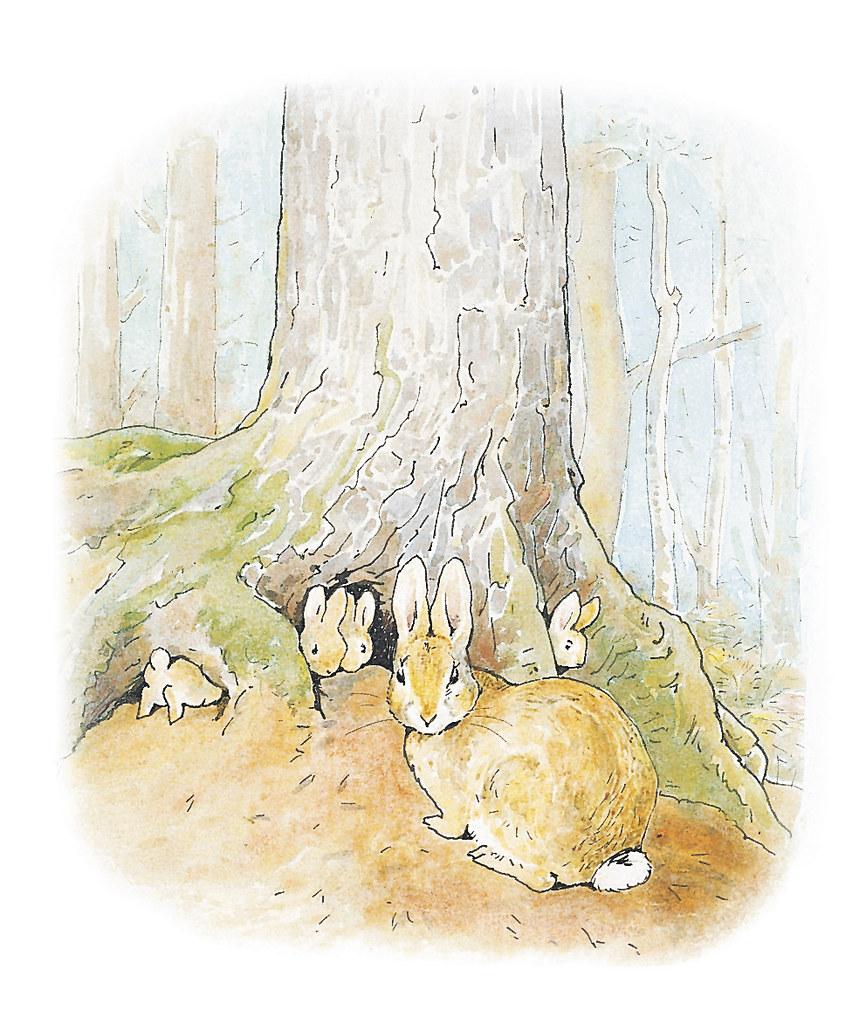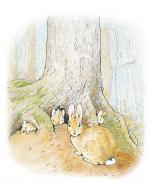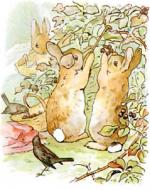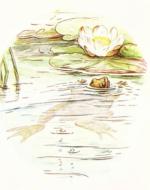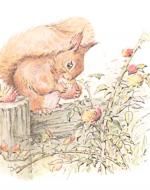Created by Meesha Ryan on Thu, 04/02/2020 - 12:09
Description:
Beatrix Potter's Victorian illustrations combine the whimsy important to children's literature and the anatomical and environmental correctness of a naturalist artist in the fashion of Sir John Everett Millais. Potter (1866-1943) incorporates elaborately illustrated plants and animals into each of her works in order to recreate the natural habitats of the animal characters. Potter also makes a great effort to replicate the movements of each animal model through the authentic depiction of their body parts, which contributes greatly to the success of her picture books.
Beatrix Potter, "They Lived with Their Mother in a Sand-bank, Underneath the Root of a Very Big Fir-Tree," The Tale of Peter Rabbit, 1902. The first image in this case is the very first illustration in The Tale of Peter Rabbit. Beatrix Potter depicts the family of bunnies in a naturalistic setting. In contrast to illustrations that appear later in the story, Potter illustrates the family of rabbits without human clothing and in a beautifully detailed rendition of their natural habitat. Potter includes the moss, surrounding forest, curving tree roots, and textured bark that would be found in this setting. Furthermore, each rabbit looks like an authentic Belgian rabbit after the model that Potter used to illustrate them, her own pet rabbit, Peter Piper.
Beatrix Potter, "Flopsy, Mopsy, and Cotton-Tail, Who Were Good Little Bunnies, Went Down to the Lane to Gather Blackberries" The Tale of Peter Rabbit, 1902. The second image in this case is also from Beatrix Potter's collection of children's literature. She complicates the naturalism of this scene by including in the illustration the little bunnies' clothing in a pile behind them. Overall, Potter retains a very naturalistic approach by including carefully drawn colored images of the grass and blackberry bushes, the little birds eating the berries, and realistically rendered rabbits in Flopsy, Mopsy, and Cotton-Tail.
Beatrix Potter, "Mr. Jeremy Bounced Up To the Surface Of the Water. Like A Cork" The Tale of Mr. Jeremy Fisher, 1906. In the stories that followed Peter Rabbit, Beatrix Potter maintains her naturalistic style of illustration. Mr. Jeremy Fisher, who is a pet of the upper reaches, is illustrated as unclothed in the water amidst the water lilies that can be found in a real pond. He is shown as a naturalistic frog through his movement in the pond, his webbed feet, and bulging eyes.
Beatrix Potter, "Squirrel Nutkin Gathering Pincushions from a Briar Bush" The Tale of Squirrel Nutkin, 1903. In anticipation of illustrating her characters in Squirrel Nutkin, Beatrix Potter created several squirrel studies of the British red squirrel that would allow her to capture the shape and movement of squirrels. Squirrel Nutkin is unclothed in this image, his large and fluffy tail resting over his back. Potter expertly balances Squirrel Nutkin on a detailed wooden fence as we often see squirrels in nature. Potter includes in her illustration intricate pincushions and leaves on the Briar bush, details which recreate what we might see if we were to walk by a fence with plant life and a squirrel on it.
Sir John Everett Millais, Dew-Drenched Furze, 1889. Beatrix Potter was inspired by Sir John Everett Millais (1829-96), a leading British naturalist artist; Potter notes in her journal on the date of Millais's death: "I shall always have a most affectionate rememberance of Sir John Millais. . .he really paid me a compliment for he said that 'plenty of people can draw, but you and my son John have observation" (qtd.in Golden, Serials to Graphic Novels, 166). In this painting, Millais depicts a Scottish landscape with great attention to detail. The intricate plant life, flecks of light against the leaves and grasses, and the colors of the rising sun are all expertly incorporated into this painting. Potter's work takes after that of Millais in this degree of attention to one's surroundings in including authentic nature settings in her book illustrations. Potter's animal characters appear naturalistic, regardless of if they are wearing clothing, because she depicts them in their natural habitats.

